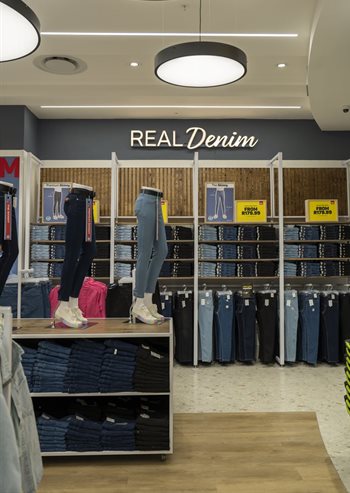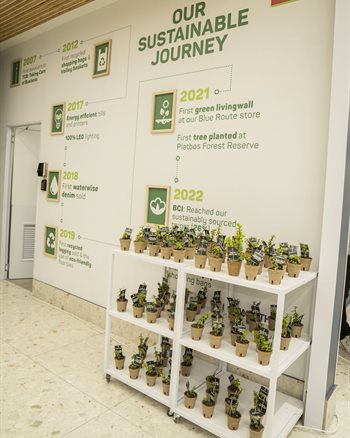Trending




 Sabre EMEA 2024 Awards: Razor PR, Retroviral top SA agenciesDanette Breitenbach
Sabre EMEA 2024 Awards: Razor PR, Retroviral top SA agenciesDanette Breitenbach
Elections 2024
Jobs
- Account Executive - Dubai Dubai, United Arab Emirates
- Sales Consultant Bushbuckridge
- Sales Representative - Labels and Packaging Midrand
- Sales Representative Bushbuckridge
- Field Sales Representative Nelspruit
- Sales and Marketing Consultant Nelspruit
- Account Sales Agent Nelspruit
- Area Sales Consultant Bushbuckridge
- Outbound Sales Associate Nelspruit
- Promoters Bushbuckridge
PnP Clothing unveils new-look store, its biggest and greenest yet

The new-look store design has been introduced at the revamped 1,000m2 Canal Walk flagship in Cape Town, which is now the biggest and greenest Pick n Pay Clothing store in South Africa. The new four-star green-rated store, which opened its doors this month, was designed with a strong sustainability focus and it incorporates features that save energy and reduce environmental impact.
Going forward, all new Pick n Pay Clothing stores and revamps will sport the same look and feel, and green philosophy.
Pick n Pay Clothing reported impressive sales growth of 14.8% over the past six months and is a key growth driver for the retail group. Through redesigned stores, Pick n Pay aims to enhance the in-store experience for customers.


Energy efficiency, recycled materials
The large Canal Walk store is now in a new location with two entrances and offers a wide range of clothing and accessories for women, men, children, and babies.
Visitors to the store will notice vertical displays and smaller aisles that help create a more open shopping environment. The store incorporates the latest fixtures and technology, such as LED lighting and energy-efficient printers and till points, but has a strong reduce and reuse ethos underpinning the design.
Most of the store fixtures – including hangers, rails, mannequins, trolley baskets, shopping bags, wooden display tables and aluminium entrance doors – have been made using recycled materials.


Online energy meters measure and manage energy usage, and through the store’s energy-saving initiatives, Pick n Pay expects to save up to 20% in electricity per store.
Pick n Pay Clothing stores are increasingly switching to solar inverter-lithium battery solutions as a more sustainable option during load shedding. This is expected to be rolled out to more than 80% of stores by the end of November this year.
Other updates include the addition of striking plant walls to act as natural air filters and mood boosters. According to the retailer, the walls have been designed to help stabilise the temperate of the air conditioning to improve the store's energy efficiency further.
The retailer is also planting 100 trees at Platbos Nature Reserve for every store opening, and by the end of 2022, 5,000 trees would have been planted.
At the official store launch on Thursday, 22 October, Hazel Pillay, general manager for Pick n Pay Clothing, said the brand embarked on a conscious sustainability journey in 2019. “This was originally to accelerate how we sourced and produced our ranges, but it quickly expanded to our stores. We now have a completely refreshed look which has been designed to incorporate a range of sustainability features to meet green standards.”
Pillay also shared that around 45% of the retailer’s latest summer store range also includes a sustainable feature. “Waterwise practices were used to produce our denim, our tights are made from recycled fabrics, and our tee shirts are Better Cotton certified.”
Expanding footprint
In the last six months, Pick n Pay Clothing has opened 28 new stores, exceeding the total number of stores opened in 2021. By the end of its 2023 financial year, Pick n Pay Clothing would have opened more new stores than the last three years combined.
The brand’s physical retail offering is complemented by online sales through the dedicated Pick n Pay Clothing online platform, launched in 2020, and the ongoing partnership with e-tailer Zando.
Speaking to Bizcommunity at the store launch event, Pillay said that while the bulk of Pick n Pay Clothing sales are still generated in brick-and-mortar stores, both online and physical channels are important to the customer journey.
“I think the customer of today is looking for an omnichannel experience, so they might predominantly shop online or predominantly be in stores. Some consumers are shopping on both channels - browsing online and then purchasing in-store or trying something on in-store and finishing their purchase online. So [the channels] work together and are equally important,” she said.
“For us, organising the best journeys around what the customer wants is critical … The journey is completely transformed and it’s not exclusive to just one channel,” Pillay added.












